[ez-toc]
The problem with bull markets is that making money might appear to be too much pleasure. Meanwhile, drops in a bear market raise the heart rate. However, investment becomes tedious when markets do nothing month after month.
Welcome to the doldrums of investing.
In Russell Crowe’s maritime adventure Master and Commander, Captain Crowe, the ship, and the crew are literally going nowhere.
The drama of a sailboat slicing across the waters has been forgotten, day after day, on the ocean. A storm would be welcome. Fatalism sets in. Nobody signed up for (or was coerced into) dying of thirst on a floating island in the middle of nowhere.
If the ship does not restart, they will all go insane or cannibalistic.
Was that a breath of fresh air? No, just another weary sailor.
One of the younger officers is eventually labeled a ‘Jonah’ by his superstitious shipmates. The unfortunate man is pushed overboard while clutching a cannonball.
Grim, but then the sails bloom and the ship takes off.
Is correlation not the same as causation? Tell that to a parched sailor the next time the wind is at his back.
There be dragons
We’ve all read – or even written – about how excellent investing should be dull. Get your thrills from your PlayStation or a skiing vacation.
That’s correct.
Except you’re reading an investment blog. I believe it is safe to say that we are all a little bit more… involved in investing here.
Also, as intelligent twenty-first-century citizens familiar with behavioral economics, incentives, and ‘nudge theory,’ we understand that the most essential thing is to resist the inner temptation to throw anything – or anyone – overboard just to break the monotony.
But just because we know what we should do – stick to our best plan until the breeze returns – doesn’t mean we will.
Some of you are still shrugging your shoulders. So much is self-evident.
Excellent work! Continue reading for reinforcement, or join the other swots for an early break.
Newer investors wonder if it’s fatal that they lost out on the low-interest-rate era’s gains. Older workers ask if an unfavorable sequence of returns is delaying their plans for early retirement.
Savings accounts appear to be ripe. And currency does not give you the willies by lurching into the red. Should we prefer that to all this investment nonsense?
How about Bitcoin? Since New Year’s Eve, the crypto-cockroach has increased by 75%.
That’s much better! Maybe this index tracking stuff has reached its limit?
Bonds? Don’t bring up bonds with me. More like a sixty-farty portfolio.
Batten down the hatches
I understand your dissatisfaction. Depending on what you invest in and how you invest, your portfolio may have been stagnant – or worse, declining – for a year or more.
In the broad scheme of things, not much. But it’s also not nothing in a 30-year investment horizon.
As recently as March 2021, my portfolio was within a few percentage points of its (brief) all-time high. It was more than two years ago. Despite a recent uptick, I can easily see returns from that ecstatic 2021 spring treading water for the next four or five years.
I don’t anticipate it, but it is possible. Especially given the shift to increasing interest rates and inflation.
So don’t be put off by macho commenters who declare they’re not bothered. Their point of view is correct, but there’s no need to be stubborn about it.
Nobody gets into investing unless they want to make money. When investing is dull or worse, it’s wiser to acknowledge defeat. Feel the annoyance. Then, rather than throwing in the towel, devise counter-measures to keep you going.
We all have a celebrity investor, money blogger, or economic commentator we’d have to walk the (metaphorical) plank for to get our portfolios moving.
However, enough about Nouriel Roubini. What are some practical approaches you may take if you’re stuck in a similar dead-end market?
Let’s look at a few things that can be useful, depending on whether you’re a good passive investor or a bad active one. Then some general recommendations for all of us.
Passive investing isn’t meant to be exciting…
…but it’s even more difficult when it’s as bland as dishwater.
If you have a simple portfolio, such as a LifeStrategy fund or a two-fund equity/bond split, checking in when markets are drifting for years can feel like a hamster on a wheel.
You’re putting in a lot of effort. You’re putting your money away. There isn’t much to show for it.
The market cannot be forced higher. However, here are some options.
Look at long-term charts. Remember that indices might remain submerged for years. A deep dip is not uncommon. This will not improve your results, but it will make you less upset about them.
Count your units. Is there a more positive measure you might track if your portfolio value is frozen in amber? Perhaps how many units of your tracker fund or how many shares of your favorite ETF you’ve purchased? Or just the entire money you’ve saved so far. It’s all building the framework for future gains if prices rise again.
Recall the worst is probably past for bonds. On bonds, I’ll say it again. Yes, they had a bad 2022. If you possessed them, you’d probably prefer not to. That, however, is water under the bridge. The bond market’s decline last year paved the stage for stronger returns in the future – or at the very least made more seriously negative periods less likely. Bonds should contribute to your total portfolio’s performance from here.
Don’t forget about income. Bond yields have risen in recent months. Dividend yields are also rising. The mainstream indices may not move, but income will. It should be reinvested. Since 1999, the FTSE 100 index has been almost completely flat. However, with dividends, you more than quadrupled your money. Not spectacular, but far superior to nothing.
Consider complicating your portfolio. A final – heretical – thought. Most people will fare better with an all-in-one fund since it conceals how the sausage is made. The investor will have no idea what is going well or poorly. As a result, they will not conduct wealth-damaging acts in reaction. However, it’s feasible that you’d benefit from viewing a circuit board rather than a black box. We can monitor the operation of our Slow & Steady model portfolio. Even though nothing is occurring on the outside, it is not lifeless on the inside. Could you allocate a portion of your equity allocation to a value and/or momentum ETF?
Or should you take a more clearly diverse approach? Or should you set aside 10% for a speculative sub-portfolio? This may lower your earnings. However, if it keeps you interested in investing, it may be a cost worth paying.
Active investors can always do something
I stopped hedging my bets by having a foot in both camps and became a full-fledged investor early in the 2007-2009 financial crisis. I learned that ‘doing something’ was the best fit for my personality. It also coincided with my strong interest in economies, innovation, and markets.
However, active investing’s greatest strength is also its greatest weakness. In theory, you can trade your way around the worst stocks while owning the best in any market. In practice, however, most people fail to do so. They aggravate the situation.
For example, last year was termed “annus horribilis” for UK investment managers. After complaining about ‘stupid’ money driving up prices during the extended bull market, the bulk of active funds failed to outperform their index-tracking counterparts when the music stopped in 2022.
As a result, most people will exacerbate the situation by stock picking or market time. But we’re unique, right? Or perhaps you like to invest actively. That’s fine as long as your eyes are open.
Look below the surface. When you invest actively, indices don’t matter nearly as much. Even when markets are stagnant, there is always a lot of activity at the corporate and industry levels. Last year, for example, was fantastic for energy companies.
Monitor your watchlist. It’s amazing how much a company’s share price fluctuates between highs and lows in a year. In confused and directionless markets, a favorite and generally costly firm may trade cheaply for a while. However, you must be on the lookout for these chances at all times.
Rotate or recycle. Most of us have shares that we know aren’t going to blow up, but we keep them for their consistency. They are frequently interchangeable with one another. While Procter & Gamble soars, Unilever languishes. There could be a valid cause. Or it could be changing fashion. Consider making an exchange. The same can be said for entire industries.
Look for anomalies. Things become routine in bad markets, which appears strange when investors are confident. For example, massive reductions on riskier investment trusts. Or housebuilders or gold miners trading in the opposite direction of the products they produce. There will frequently be cyclical aspects to consider. However, if you accurately determine which signal is superior, you may be able to find a bargain.
It’s always a bull market somewhere. I’m not sure who said it, but it’s true. Be wary of bouncing from craze to fad and becoming the last buyer standing clutching the bag each time. However, if you can land on a long-term bull market and you know your onions, it may be really beneficial to have a large portion of your portfolio rising when everything else is falling. I know it sounds basic, but you’d be amazed how many active investors stay pounding away at the same disintegrating coal-face for years instead of looking for a more promising seam to mine.
You probably want to keep thinking long-term. The most successful active investors appear to be long-term players rather than frantic traders. So, while I believe certain trading tactics might be beneficial, I would utilize them within the context of attempting to build my finest portfolio of long-term ideas. Beware of ending up with a basket of bad cheap companies in which you have no faith if (/when) things go wrong unless it’s your plan and you’ve demonstrated you’re good at it. Remember, the winner takes all. The majority of the market’s return is generated by a small number of outstanding companies. You should despise not owning them.
How we can all keep the momentum going
Whatever you choose to invest in, the overall picture is as timeless as an avocado bathroom suite in Swansea.
Try to be happy. Expected are returns up. Yes, you’d rather that your portfolio’s prospects improved for positive reasons – stronger corporate profitability or a thriving economy – rather than because everything plummeted dramatically last year. Nonetheless, those drops wiped away most of the valuation froth in stocks and bonds. It’s realistic to expect higher returns during the next 10 years than in 2021.
Save more. You can’t make the market dance to your tune, but you can make it laugh and toss money at you. Markets that are stagnant or even decreasing are beneficial to savers. They allow you to purchase more assets for your money. If you’re under 40, you might even hope that world markets remain horizontal for the next 20 years.
Think long-term.In the larger scheme of things, the last 12-18 months don’t really matter. If you save and invest for another 20-30 years, you’ll be hard-pressed to see any skewed data. True, this is more difficult when your time horizon is shorter. All I can say is that this is why your portfolio should reflect your age (or even your relationship with regular paid work).
Make money through cost reduction and tax mitigation. Markets cannot be controlled. However, you can ensure that your investments are efficient. To begin, look at our broker comparison table. If you possess expensive funds, you should understand why. Being tax-efficient can also help you shift the needle. If you have unsheltered assets, for example, reduce capital gains.
Check your portfolio less frequently. Not knowing what’s going on is an easy way to feel better about a portfolio with a slow puncture. Check-in once a year, and you’ll get at most one surprise every year. You’ll be pleasantly pleased more frequently than not. Most readers will want to look at their portfolios more frequently, but keep in mind that the more frequently you do, the more likely you will be disappointed.
Check your portfolio more frequently. Is it possible that I’m contradicting myself? Without a doubt! Only for investing nerds who feel out of control when they lose money. Proceed with caution, but it’s feasible that witnessing everyday gyrations will help you develop a stronger shell and strengthen your drive to put more new money to work. That’s exactly what happened to me.
What’s the worst that can happen? It could be useful to calculate how bad things can get. Examine the worst markets of all time and apply what you’ve learned to your circumstance. Could you put up with it? You wouldn’t be happy, but it wouldn’t be the end of the world either. Facing your concerns can take away their power. Consider cutting your portfolio in half. What would your reaction be? The response may compel you to act, but before you do, repeat the practice tomorrow. It may lose its sting, while also making routine gyrations of 5-10% seem insignificant.
Hold fast
It is not difficult to go over a rough patch in the stock market. Most of the suggestions above may appear obvious to you.
However, good investing is simple but difficult.
Few of us will be able to look back and see outstanding decisions or insights as the source of our investment fortunes. Rather, it will be sticking to it through good and terrible times, adding new money and gradually compounding it over decades, that will bring us financial freedom.
Markets that are choppy can make you seasick. Markets that are frothy might throw you off course.
When investing becomes tedious, the greatest risk is that it all seems pretty pointless.
Do everything you can to remind yourself why you’re investing, why you’re reading Monevator, and where you want to end up.
I’m confident that we’ll go back there sooner or later.





